Day 13: Goondiwindi > Coonabarabran
(well, not quite, but nearly)

Thursday morning didn't quite see is up to catch the sunrise, but we weren't far off after a night that, in Bowen terms would have been classed as chilly, on the verge of winter but in these parts is probably par for the course as far as April and May are concerned,
A quick glance around the other centres on the Weather app revealed 10.1 was about par for the course where we were headed, and a quick check around the same as I sit tapping away at six on Friday morning doesn't reveal as much about Coonabarabran, but suggests 7 in Canberra and 6.3 at Orange Airport. Fortunately we've packed the winter woolies (such as they are).
But, as is so often the case we're getting ahead of the narrative, which at this point involves a skimpy breakfast, at least on Hughesy's part, followed by the ritual packing and stowing of everything we'd lugged inside the previous night. One day, doubtless, we'll get things together as far as this traveling caper is concerned, to the point where we can grab just one bag each, with maybe a box of essentials and the esky, leaving most of the stiff in the car, but that point is still some time in the future.
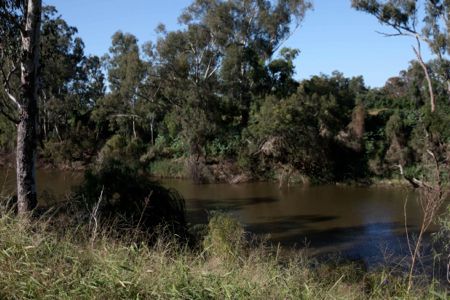
By eight thirty we were on the road, if only briefly, headed downtown for a walk along the banks of the McIntyre and a look at the Information Centre and the Gunsynd Museum. The Goondiwindi Grey's career ended just before Hughesy's spell on the punt, so there weren't too many familiar names in the photos along the wall of the Museum, but there we go again, getting ahead of ourselves.
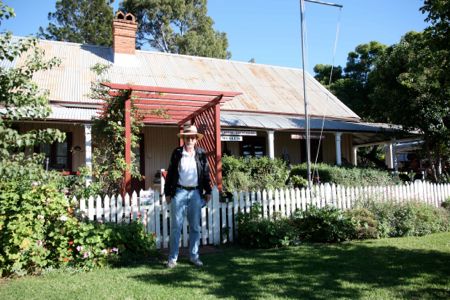
We parked in the grounds of the Information Centre and set off for the riverbank, noting the Customs House Museum along the way. It definitely looked worth an extended look, but it doesn't open till ten, and closes at four, so I don't like our chances, presuming we're ever back this way.
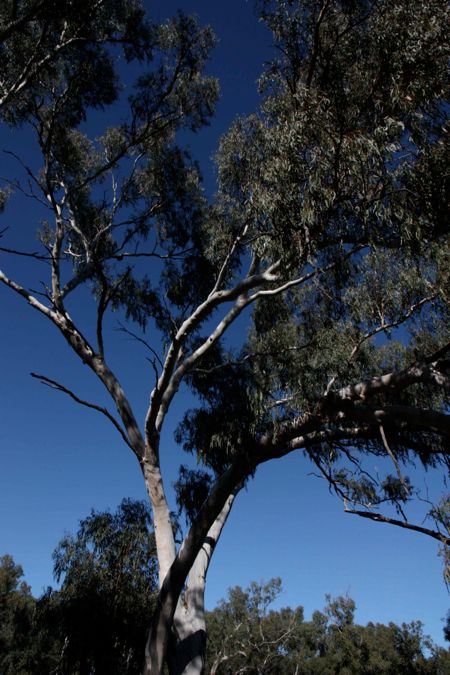
We speculated about flooding issues as we strolled along the levee bank, which, frankly, I thought would have been higher, passing the Hospital and the Bowls Club before heading back through the main drag so Madam could take a photo of the Victoria Hotel, sighted on the previous evening's excursion, which had interesting architectural features reminiscent of the iconic winery at Tahbilk.
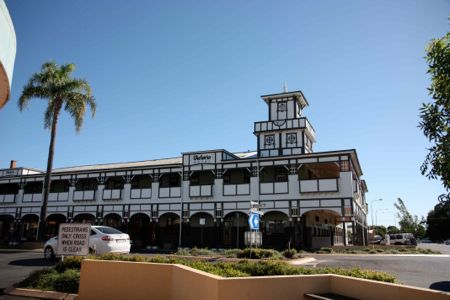
Back at the Information Centre, we discovered the recent floods hadn't broken the levees, though they'd cut the town off in all directions, and a stroll through the Gunsynd Museum revived hazy memories of the pre-punting past.
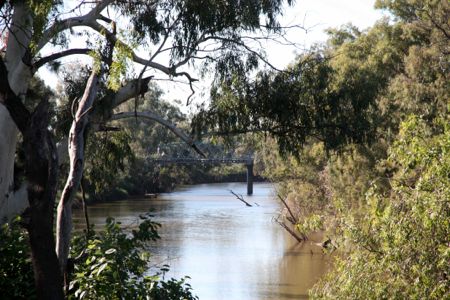
We took the old highway out of town, crossing the bridge that replaced the original punt and rope crossing back in the late nineteenth century, and headed south through Boggabilla towards Moree, where Madam was intrigued by the idea of an art deco townscape and I was interested in the possibilities for brunch.
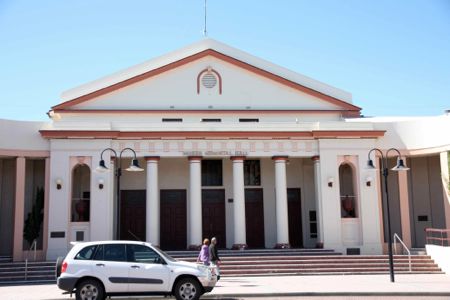
The townscape was intreating, though probably not worth going out of your way for, with substantial bowers along both sides of the main street, and brunch was a plate of bangers and mash ($10, but perfectly acceptable at the Wine Bar that serves as the cellar door for Woolaway Wines.
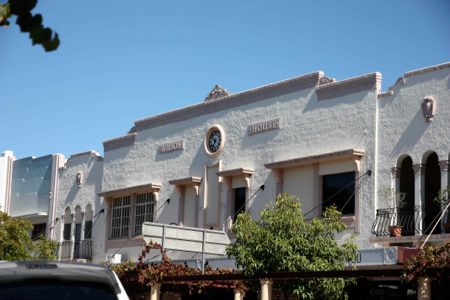
While waiting for the bangers I sampled the Verdelho, which was pleasant enough, with the requisite tropical fruit notes rather than overtones, but didn't stand out enough to warrant buying a bottle, and the Rose, which was in the sweeter style, which I tend to avoid.
From there it was a case of replenishing the garlic supply, which involved a compass and a cut lunch circumnavigation of the building with the Coles sign, and gave me another occasion to muse on the habit of people with a substantial load of shopping to use the twelve items or less checkout.
There was an old bloke unloading his trolley at the adjacent checkout who'd barely finished before I got through next door, having followed a woman with a chatty kid who interacted at some length with the checkout chick, and a woman who needed a packet of lollies, presumably as an aid to driving.
A garlic bulb set me back $1.20, but lack of a dollar coin had me getting a dollar's change, which the checkout chick advised against spending all at once.
We headed back out to the bypass, which brought us back to the other end of the main drag, checking the fuel options (last fuel stop had been Warwick) but with a little over a hundred k to Narrabri with a seventy k round trip to Sawn Rocks thrown in along the way felt we'd have enough to get us safely there, with enough left over to allow a slight further diversion if necessary.
The country, all the way from Goondiwindi to Moree had been flat, featureless, and largely devoted to broad acre farming, with cotton featuring heavily. Grain silos en route suggested possibilities of wheat, barley or sorghum (or quite possibly something else, things have definitely changed in these parts since Hughesy's dimly remembered High School Geography classes) though there didn't seem to be much grain in evidence.
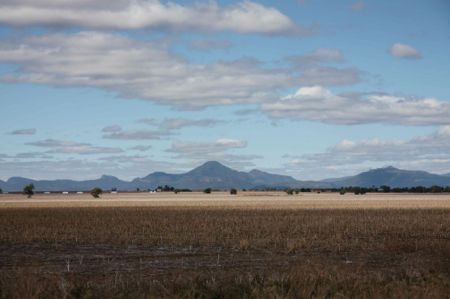
South of Moree we sighted mountains on the horizon, guessing, correctly as it turned out, that was where we were headed if we wanted to see this interesting geological phenomenon.
The Sawn Rocks turnoff is about three kilometres north of Narrabri, and Madam had some reservations about the road, which turned out to be comfortable two lane bitumen rather than the unsealed surface she'd feared.

It's 33 km each way, but if you're in these parts and have the time on your hands it's a pleasant drive, and a 750 metre walk along a good track delivers you to the foot of this quite remarkable feature, allegedly the only one of its kind in the country.

Personally, as interesting as the organ pipes were, I was impressed by the absolute straightness of the edges of the fallen rocks.
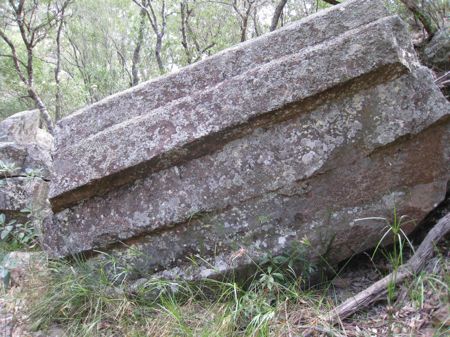
Back in the car, we made it into Narrabri with ample fuel to spare, and then it was off in search of the night's accommodation, the Poet's Cottage at Pilliga Pottery.
Most of the drive took us through Pilliga State Forest, and the turnoff, around 25 km north of Coonabarabran, leads onto around ten kilometres of corrugated unsealed road that twists and turns through the forest.
The outside signage described it as a scenic drive, which I thought was stretching things a bit unless you were a seasoned off road four wheel drive enthusiast, but the Pottery, when we arrived, turned out to be an interesting, isolated and eco-friendly establishment.

Given the state of the road, one doubts there'd be too many visitors at the Blue Wren Bush Cafe, and one suspects that shipments of outgoing pottery would need to be carefully packed if they were going to make it out to the highway.
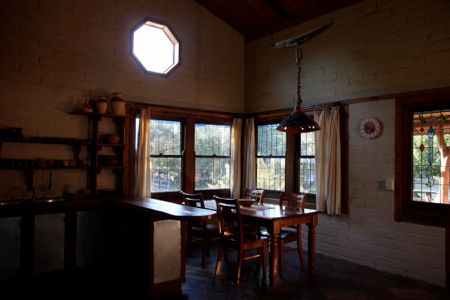
Still, once we were in the Poet's Cottage, everything was fine, provided you're willing to forego the use of extensive electronic gadgetry, which we were, and we're set firmly in the early to bed camp, so it's not like we were going to be burning the midnight oil.

That's a significant consideration since you're probably out of mobile phone coverage, even with Telstra (at least that's true for the SIM card in the iPad) and the property, being in the middle of the Pilliga Forest, is off the power grid as well.
Solar power covers all the essentials, but it's not something that you're going to be able to recharge after dark, is it?

I did, however, get the iPad close to fully charged before we retired for the night, and while the following morning's tapping ran it back down I got most of it back before we headed off for the Warrumbungles.
Dinner arrived around six-fifteen in the form of a couple of wood-fired pizzas from the Blue Wren Cafe. At $20 they're probably overpriced, but they were surprisingly filling, so we weren't complaining.
A bottle of Taylor's Promised Land Cabernet Merlot went down rather well, as did a glass or two of Pfeiffer Christopher's VP, which was the better of the two, largely drawn, if my memory serves me well, from the classic Portuguese port varieties. A very pleasant little nightcap.

